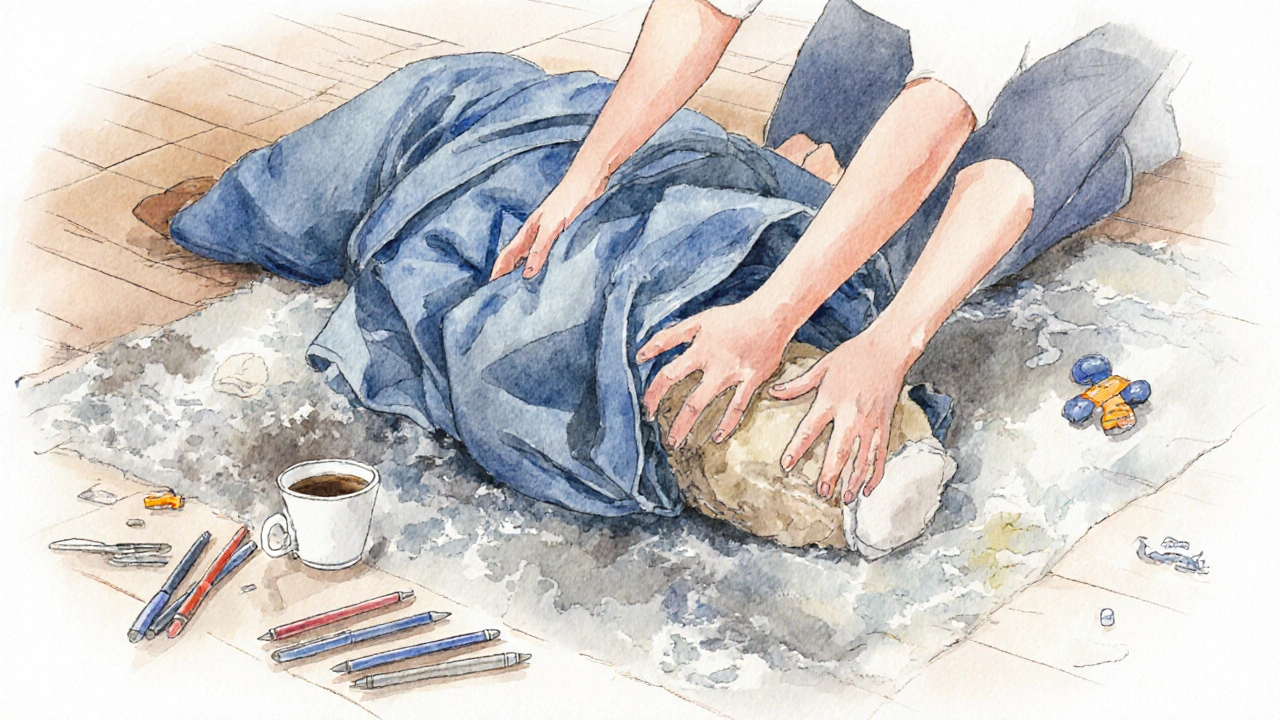Seizure First Aid: Essential Steps When Someone Has a Seizure

Seizure First Aid Guide
1Stay Calm
Your composure helps reduce panic and allows you to act effectively.
2Clear the Area
Remove sharp objects and soften the ground around the person.
3Time the Seizure
Use a watch or phone to track how long it lasts.
4Protect Head
Place a folded jacket or pillow under the person's head.
5Don't Restrain
Never hold or tie down the person during a seizure.
6Recovery Position
Roll the person onto their side once convulsions stop.
7Emergency Check
Call emergency services if seizure lasts over 5 minutes or if the person is injured, pregnant, or diabetic.
What NOT to Do
- Do NOT put anything in the mouth
- Do NOT restrain the person
- Do NOT leave them alone during the episode
- Do NOT give water during the seizure
Emergency Response Calculator
Recommended Action:
Quick Takeaways
- Stay calm and protect the person from injury.
- Time the seizure - if it lasts longer than 5 minutes, call emergency services.
- Never restrain movements or put anything in the mouth.
- Place the person in the recovery position once the convulsion stops.
- Record details to share with medical professionals.
What a Seizure Actually Is
When a seizure is a sudden, uncontrolled electrical disturbance in the brain that can cause changes in behavior, movements, consciousness, or sensations, the body may contract, jerk, or become rigid. Most seizures are brief, lasting seconds to a couple of minutes, but they can be frightening for witnesses.
Types of Seizures to Recognize
There are many forms, but the two broad categories are:
- Generalized seizures - involve the entire brain and often cause loss of consciousness.
- Focal (partial) seizures - start in one area and may or may not affect awareness.
Knowing the pattern helps you stay focused on safety rather than guessing the cause.
Immediate Actions: Step‑by‑Step First Aid
- Stay calm. Your composure reduces panic for both you and the person.
- Clear the area - remove sharp or hard objects, loosen tight clothing, and soften the floor if possible.
- Time the episode. Use a watch or phone; note when it started.
- Protect the head - place a folded jacket or pillow under it.
- Do not restrain the person's movements; they will protect themselves as best they can.
- After the convulsion stops, gently roll the person onto their side - this is the recovery position a safe posture that keeps the airway open and lets fluids drain.
- Check breathing. If breathing is abnormal, stay with them and be ready to perform CPR if trained.

What NOT to Do
| Do | Don't |
|---|---|
| Stay with the person until fully recovered. | Leave them alone in the midst of the episode. |
| Time the seizure. | Ignore the duration. |
| Place something soft under the head. | Put objects in the mouth - it can cause choking or dental injury. |
| Call emergency medical services if the seizure lasts >5 minutes, follows another seizure, or the person is pregnant, injured or diabetic. | Assume the episode will end on its own without monitoring. |
| Record key details (time, length, triggers). | Speculate loudly about the cause. |
When to Call Emergency Services
Dial 111 (NZ) or your local emergency number if any of the following occur:
- The seizure lasts longer than five minutes.
- The person has another seizure within a few minutes (possible status epilepticus).
- They are injured, pregnant, have diabetes, or are a child under one year old.
- You cannot wake them after the episode.
- It’s their first known seizure.
Explain clearly: "I’m with a person having a seizure that has lasted X minutes; they are breathing but not responding fully." This helps dispatchers prioritize.
After the Seizure: Recovery Care
Once the shaking stops, the person may feel confused, tired, or embarrassed. Offer reassurance and stay nearby for at least 10-15 minutes.
- Check for injuries and provide basic first aid if needed.
- Offer a glass of water if they are fully alert and not choking.
- Ask if they have a medical ID bracelet or card - it gives healthcare workers vital information.
- Document the event: start time, duration, observed symptoms, possible triggers, and any medication taken.
- Encourage them to rest in a safe, quiet place.
If they take antiepileptic medication prescribed drugs that help control seizure activity, remind them to follow their regular dosing schedule.
Special Situations
Status epilepticus is a medical emergency where a seizure persists for more than five minutes or repeats without full recovery. Immediate EMS activation and, if trained, administration of rescue medication (e.g., rectal diazepam) is critical.
For children, keep the head supported and avoid holding them too tightly. In pregnancy, extra caution is needed; seizures can affect both mother and fetus, so prompt medical review is essential.
Common Myths Debunked
- Myth: You must “stop” the seizure by holding the person. Fact: Restraining can cause injury; let the seizure run its course.
- Myth: The person will swallow their tongue. Fact: The tongue is attached to the floor of the mouth; choking risk is low, but a bite can happen.
- Myth: You need to give them water during the event. Fact: Giving anything by mouth can block the airway.
- Myth: All seizures lead to loss of consciousness. Fact: Some focal seizures keep the person fully aware.

Frequently Asked Questions
How long should I wait before calling emergency services?
If the seizure lasts more than five minutes, if a second seizure starts quickly after the first, or if the person is injured, pregnant, diabetic, or a child under one year old, call 111 (NZ) immediately.
Can I give the person something to eat or drink after the seizure?
Only offer water or food once they are fully alert, can swallow safely, and have no nausea. Until then, keep the airway clear and monitor breathing.
What should I do if the person bites their tongue?
Gently rinse the mouth with clean water if possible, apply a cold compress to the outside of the cheek, and seek medical attention if bleeding is heavy or the bite is deep.
Is it safe to move the person during a seizure?
Only move them if they are in danger (e.g., near traffic or a fire). Otherwise, keep them where they are, protect the head, and wait for the activity to subside.
What details are most helpful for the medical team?
Note the start time, length, type of movements, breathing status, any injuries, known triggers (like flashing lights or missed medication), and current medications.
Armed with these practical steps, you can provide confident, effective seizure first aid that protects the individual and eases the anxiety of everyone nearby.

Jolanda Julyan
October 4, 2025 AT 14:27First and foremost, keep your head cool when a seizure strikes, because panic does nothing but magnify the chaos. You must stand firm, take a breath, and remind yourself that you are the calm in the storm. The moment you see convulsions begin, clear the surrounding area of anything sharp that could shred skin or bruise bone. Move chairs, tables, or even a stray laptop away with decisive force. Then, check the floor. If it’s hard, grab a jacket, a pillow, or any soft item you can use as a cushion for the head. It’s not optional; it’s essential to guard the brain from impact. Next, grab your phone and start the timer without hesitation, because every second counts in determining the need for emergency services. Don’t waste precious moments debating what to do; act now. When the shaking subsides, gently roll the person onto their side – the recovery position – and keep that airway open. Do not, under any circumstances, try to hold them down or tie their limbs, because doing so only adds injury risk. Stay with them, watch their breathing, and be ready to call 111 if the episode drags beyond five minutes or if they’re pregnant, diabetic, or visibly hurt. Never leave them alone while the episode is ongoing; abandonment is unacceptable. If they regain consciousness, speak softly, reassure them, and remind them how brave they were. Finally, jot down the details: start time, length, any triggers you noticed – this information will be gold for medical professionals. Follow these steps, and you’ll turn a terrifying situation into a manageable one, protecting lives and preventing regret.
Kevin Huston
October 10, 2025 AT 17:07The sheer drama of a seizure demands a theatrical yet precise response – think of it as a wild, untamed ballet that you must choreograph with swift, bold moves. First, you yank the crowd’s panic aside and plant your feet, because fear is a sloppy partner. Then, sweep the stage of any sharp props, any knives, any latte mugs that could become weapons. Grab a phone like a sword and start timing – every tick is a beat in this urgent performance. When the convulsions crescendo, lay a soft blanket or jacket under the head like you’d cushion a fallen star. Resist the urge to restrain; letting the seizure run its course is the only respectful applause you can give. Once the tempest settles, roll the person onto their side, a graceful pirouette into the recovery position, keeping the airway clear. Call emergency services if the show drags past five minutes, or if the lead actor is pregnant, diabetic, or injured – they’re the backstage crew you need. And don’t forget to jot down the act’s details for the medical director later. This isn’t just first aid; it’s a vivid, decisive drama where you’re the star of calm and competence.
Amanda Hamlet
October 16, 2025 AT 19:47Okay, listen up, because I’m about to drop some knowledge that even the medical textbooks wish they could copy. First, stop staring like a deer in headlights – you’re not helping anyone. Clear the area fast, like you’d clear a table after a messy dinner – no swords, no knives, no pointy things. Then, get that timer on your phone, not your grandma’s old watch, because precision matters. Protect the head with a jacket – anything soft will do, even your hoodie if you’re lucky. Don’t try to hold the person down; it’s stupid and can cause more injuries. When the shaking stops, roll them onto their side – that’s the recovery position, not some fancy yoga pose. And call 111 if it lasts more than five mins or if the person has a condition like diabetes or is pregnant – they’re not just an excuse, they’re a real risk. Write down everything – start time, length, what triggered it – you’ll thank yourself later. Trust me, I’ve seen way worse, but follow these steps and you’ll avoid a disaster. So stop being clueless and act like you actually care.
Nolan Jones
October 22, 2025 AT 22:27yeah, i get what jolanda's saying – staying calm is key. just make sure you actually move stuff out of the way, not just stare at it. a jacket works fine for the head, no need for fancy gear. timing on your phone is good, but don't get stuck scrolling social media while you count. after the seizure, the recovery position is simple – roll them onto their side and keep the airway open. keep an eye on breathing, and call EMS if it's over five minutes or if they got hurt.
Jada Singleton
October 29, 2025 AT 01:07Kevin, your flair is noted, but let’s cut to the chase: the steps are straightforward and don’t need poetic embellishment. Clear the area, protect the head, time it, avoid restraints, and roll to the recovery position. If the seizure exceeds five minutes or the individual is pregnant, diabetic, or injured, dial emergency services immediately. The emphasis should be on clear, precise action, not on dramatics.
Emily Rossiter
November 4, 2025 AT 03:47Amanda, I appreciate your confidence, but remember that everyone reacts differently in emergencies. The key is to stay calm, move dangerous objects away, use something soft for head protection, and time the seizure. After it ends, gently place the person in the recovery position and monitor breathing. Offer water only once they’re fully alert. These are the reliable steps that work for most situations.
Renee van Baar
November 10, 2025 AT 06:27Nolan, great point about practicality. To add, when you’re clearing the area, it helps to also check for any loose clothing that could restrict breathing and gently loosen it. If the person is on a hard floor, placing a thick blanket or folded clothes under the head provides better cushioning than a thin jacket. And remember, after rolling them onto their side, tilt the head slightly back to keep the airway open. These small adjustments can make a big difference in comfort and safety.
Mithun Paul
November 16, 2025 AT 09:07Jada, while your succinct assessment is appreciated, let us consider the procedural rigor required in such scenarios. It is imperative to document the seizure’s onset timestamp, duration, and any precipitants with exactitude. Moreover, the decision to summon emergency services must be predicated upon established clinical thresholds, such as seizure duration exceeding five minutes or the presence of comorbid conditions. The adherence to these protocols ensures optimal patient outcomes and aligns with best practice standards.